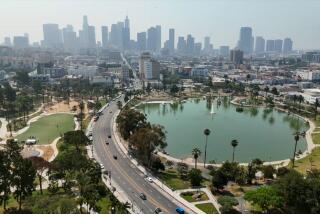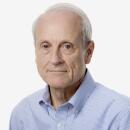Eagle Rock remade for cyclists -- and slower traffic
- Share via
It wasn’t always clear, at least not right away, who was joking and who was serious at a contentious June community showdown over plans to rethink and remake Colorado Boulevard in Eagle Rock. The woman who warned that removing a traffic lane in each direction would turn her neighborhood into a Bantustan, like those ethnic enclaves in South Africa where ingress and egress were tightly controlled – it turns out that she was being serious. The man who listed a dozen or so dangers associated with re-striping for bike lanes – for example, city workers might accidentally stripe over small animals and become distraught at what they had done, and cyclists wearing tight-fitting outfits would be a titillating distraction to motorists – surely he was just having some fun at the expense of the bike opponents.
Nearly four months later, on Sunday, the crowd in the same Center for the Arts room was smaller and the atmosphere more celebratory. Outside, the restriping of Colorado Boulevard was nearing its conclusion, leaving two lanes for cars in each direction instead of three, bike lanes on each side, a buffer to separate bikes and cars – or, in the eyes of skeptics, wasted space – and “Continental-style” crosswalks, in which the entire pedestrian walkway is striped to make it even harder to miss from behind a steering wheel. Inside, supporters of the organization Take Back the Boulevard celebrated the success and unveiled a Vision Plan to lay out where the street should go from here (see the Take Back the Boulevard video here).
Renderings depict the Main Street of a leafy low-rise town with sidewalk cafes, cyclists and strolling families. In truth, much of Colorado Boulevard already looks like that; Eagle Rock has always had a community vibe, and residents and businesses have been sprucing up their community over the course of several years. The boulevard has a mix of business fronts, including modern strip malls with parking in the front between the sidewalk and the stores; 1960s-era drive-ins with parking in lots to the sides; and older storefronts right on the sidewalk with parking in lots in the back or limited to the street. There is an acclaimed arts high school that used to be a shoe store, a converted garage that’s now a well-known vegan restaurant, classic burger places and coffee shops. Post-modern and retro mix comfortably.
But until this month, businesses looked out at each other across what was in essence a six-lane freeway of speeding traffic. It once actually served that purpose, but 40 years have passed since the 134 was built across the foothills, connecting the San Fernando Valley to Pasadena. Traffic volume on Colorado Boulevard wasn’t that high; but the ample room made cars move all the faster.
It didn’t help that the portions of the boulevard that move through Glendale and Pasadena were already only two lanes in each direction. Eagle Rock became the place for drivers to pick up the pace. The little old lady in the famous Jan & Dean and Beach Boys song may have been from Pasadena, but she likely became “the terror of Colorado Boulevard” on the stretch that passes through Eagle Rock.
Community leader Bob Gotham said residents and business owners complained that the boulevard was not safe. Traffic was too dangerous, and there were not enough crosswalks. The Eagle Rock Assn. and other local organizations formed Take Back the Boulevard, which worked with Councilman Jose Huizar’s Office to engage residents in discussions about what they wanted.
“The point the community reached early in the process was on the speed of traffic,” Gotham said. “Slowing down traffic was the number one goal.”
Buffered bike lanes weren’t the primary goal. But the city’s 2010 Bicycle Plan had just been completed and adopted and called for bike lanes on Colorado Boulevard; legislation exempted bike lane restriping projects from the controversial and sometimes cumbersome California Environmental Quality Act had been adopted; and Proposition R provided funding. Adding bike lanes fit nicely with community plans to reallocate space on the boulevard from people who use it to pass through, getting as quickly as possible from Glendale to Pasadena, and those who shop, work and live in Eagle Rock. Many people at the contentious June meeting – and one several months earlier at Occidental College – said they weren’t cyclists and didn’t expect to be, but wanted a slower boulevard and saw bike lanes as part of a street diet program to achieve their goal.
That’s an old and enduring story in Los Angeles. Who do we give our streets to: The people who want to get through as quickly as possible, or the ones who live here? Is the boulevard a Main Street or a freeway? The question underlies every decision about synchronizing signals or restricting street parking.
Eagle Rock resident Bob Arranaga said the road diet and the Colorado Boulevard Vision Plan were the result of “community activism in its rawest form.”
“People just rolled up their sleeves and got it done,” Arranaga said. “There were small groups that put their differences of opinion aside.”
Gotham acknowledged that the community divide on Colorado Boulevard re-striping was generational. “More mature Eagle Rockers were in opposition,” he said. “But my feeling is that it’s time for us to create the Eagle Rock of tomorrow. It needs to be for the people who more and more are going to be in the community.”
He said the shares of injuries suffered by cyclists and pedestrians had been increasing, but that the road diet should reverse things. “By this change there will be some people who are not going to be injured,” he said, “and that’s a wonderful thing.”
ALSO:
Can L.A. ever be a cyclists’ town?
A cyclist asks: What are the rules of the road?
California’s new cycling ‘three-foot rule’ stirs some ‘reader rage’
This post is part of an ongoing conversation to explore how the city’s cyclists, drivers and pedestrians share and compete for road space, and to consider policy choices that keep people safe and traffic flowing. For more: latimes.com/roadshare and #roadshareLA.
More to Read
A cure for the common opinion
Get thought-provoking perspectives with our weekly newsletter.
You may occasionally receive promotional content from the Los Angeles Times.











